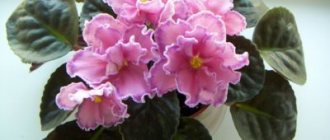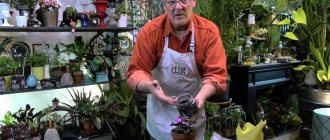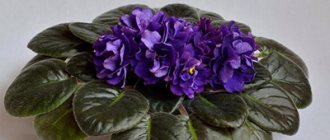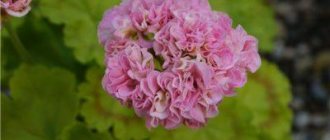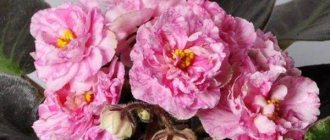The delicate and unpretentious Uzambara violet, having appeared at European flower exhibitions at the end of the 19th century, instantly attracted the attention of flower growers and gave rise to the undying interest of breeders of the Old and New Worlds in transforming its varietal qualities.
Over the years, a huge number of varieties and hybrids of the original tropical plant , and American breeders played a significant role in this.
In the middle of the last century , violet appeared in the collections of Soviet flower growers; domestic amateur violet growers actively participated in the process of its cultivation and made an invaluable contribution to improving the decorative appearance of the charming African guest.
The varieties of violets bred all over the world are conventionally divided into classic ones, found in most gardeners ’ collections, and new ones, recently introduced for sale and in particular demand.
The number of new products is constantly increasing, and previous popular varieties are becoming classics.
At the same time, good-quality classic varieties of violets gradually lose their relevance , being preserved only by the keepers of the variety and its true connoisseurs, and become retro varieties.
They may not be inferior to new products in terms of varietal characteristics and decorativeness, but they are not fashionable breeding objects.
Next, we will show you retro varieties with names and photos of domestic and foreign selection, which are still deservedly popular among violet growers.
Retro varieties of violets
According to an unspoken rule, all varieties of foreign selection obtained in the last century are completely conditionally classified as retro varieties.
IMPORTANT! Domestic varietal violets are classified as retro if they were bred before 1990. Starting from this border, for inexplicable reasons, violets acquire a decorative appearance and a modern perception that differs from retro varieties.
In the Soviet Union, Saintpaulia first appeared in Leningrad - in the Botanical Garden associated with the State University. The first specimens of violets were brought there and its director D.M. Zalessky . The breeding developments of this specialist include the magnificent varieties “Blue Danube” and “Light and Shadow”.
Boris Mikhailovich Makuni , who devoted forty years of his life to delicate violets and created more than 300 of their varieties, is unconditionally recognized as a luminary in the domestic selection of Saintpaulia In order not to divide the breeding line of the Makuni spouses (Boris Mikhailovich worked on varieties together with his wife Tatyana Nikolaevna), who created new Saintpaulias until 2002, all their varieties are considered a retro category.
Boris and Tatyana Makuni.
At the same time as the Master, many domestic breeding enthusiasts worked on the decorative appearance of violets. All of their varieties, created from the late 60s to 19990 and preserved in the collections of flower growers, belong to retro violets.
The reasons for this name
In Soviet times, only passionate non-professional flower growers . They did not know how to keep records and describe the varieties obtained, and did not think about creating catalogs and classifiers.
In this regard , many developments disappeared without a trace, and varieties were preserved in minimal quantities . It is for this reason that their violets are classified as retro.
ATTENTION! In addition, all antiques, household items and decorations that rarely appear in everyday life and carry some historical or material value fall under the term “retro”. This category also includes violet varieties bred from the last century.
Transplant rules, rejuvenation
replant Sunset if:
- The roots of the plant appeared in the drainage hole;
- Violet grows in this substrate for more than 2 years;
- There is a suspicion of stagnation of water in the pot;
- The plant needs rejuvenation or deepening;
- Signs of nutritional deficiency have appeared.
The transplant is carried out in the following order :
- Remove the lump of soil with roots from the pot;
- Shake off or remove most of the old substrate;
- Cut off excessively long, old and damaged roots, excess leaves;
- Place the roots in new soil;
- After 24 hours, water the Saintpaulia and, if necessary, add soil.
IMPORTANT! Leave the pot size the same!
When replanting , be careful in the fall . Violets are fragile and delicate and can be easily damaged.
Be sure to rejuvenate Sunset when the plant reaches the age of 2.5-3 years. If the plant lives in one substrate longer, the flowering will become less abundant and the flowers will be smaller. The violet is rejuvenated by cutting off the “head” (the growing point and 2 tiers of leaves) and then rooting it in the greenhouse.
Top varieties of domestic and foreign selection
Domestic selection
In the second half of the 20th century, a whole galaxy of passionate flower growers and self-taught breeders worked on the creation of new varieties of Saintpaulia.
Their names are unknown to a wide circle of violet lovers, but without their dedicated work, the emergence of new modern varieties of this marvelous plant would be difficult. Among them are:
- D.M. Zalessky;
- Makuni spouses;
- V.N. Kolesova;
- S.A. Aksyonova;
- L.V. Radin;
- V.A. Mikheeva;
- I.D. Lowbrow;
- S.I. Prilutskaya and many, many others.
“Beloved Daughter” (B.M. Makuni)
Saintpaulia type standard . Above a dense rosette of slightly wavy leaf blades of a dark green shade, a cloud of lavender color is formed from large corollas of simple fullness.
The petals have a wavy outline outlined in dark purple.
The peculiarity of the violet is the lightening of the color of its flowers as they open.
“Sweetie” (B.M. Makuni)
“Sweetie” is a representative of the Pink Series. Violet standard type.
The rosette with a neat outline consists of leathery, slightly long leaves of a dark tone with a marsh tint. The edge of the sheet is wavy, the reverse side is illuminated in red.
Flowering is cap, almost all year round. The corollas are pink carnations with a greenish fringe on each petal.
“Lilac Fog” (B.M. Makuni)
Standard type. Violet leaves of a dark shade with a rounded-toothed edge form a symmetrical rosette of dense fullness.
The voluminous cap is formed from wavy-corrugated terry-type corollas, colored with transitions of different tones of lilac.
The peculiarity is a very long period of preparation for flowering.
“Solveig’s Song” (B.M. Makuni)
"Solveig's Song" represents the author's Blue Series, being the best in the line . Standard.
An evenly filled, compact rosette is formed by rounded leaves the color of summer grass. Strong flower stalks support magnificent large corollas of a semi-double appearance with a wave along the edges of the petals.
Coloring - shimmering blue tones.
“Blue Danube” (D.M. Zalessky)
One of the first varieties of domestic selection. Standard type.
The neat rosette consists of rounded-toothed leaves with wavy edges, painted in the tone of dark green with an emerald vein. Corollas of simple fullness with a slightly wavy outline.
The buds are painted in a delicate tone of bluish-lilac color.
“Orchid” (V.A. Mikheev)
Based on the type of flower color, Saintpaulia is classified as a two-color violet.
The leaves are greenish-marsh in color with lighter veining and have a rounded shape with a slight point.
The simple-looking corollas are painted with shimmering lilac colors. Along the contour of the flower there is a white edging, turning into a clear pattern on the upper petals.
“Mazepa” (L.V. Radina)
The violet has a somewhat loose rosette due to the elongated leaf petioles. The leaf blades are rounded and light green in color.
The corollas are large in size, terry full.
The peculiarity of the violet is the change in the color of the bud : from a marble pattern in white and lilac tones to a dark lilac color.
“Dark Cherry Shawl” (I.D. Low-bow)
Standard type variety. The rosette is formed dense, with a symmetrical contour .
The leaves have a quilted structure, dark green color and a round configuration with a slight nose.
Flowering in a cap form. The corollas are laid in large sizes, with increased terry, a juicy shade of ripe cherries.
“Miss Moscow” (I.D. Nizkous)
Saintpaulia standard type . With a compact structure, an even rosette of dark green color is assembled from rounded leaf plates with a quilted structure on elongated petioles.
Flowering occurs with the formation of large corollas of terry fullness with waviness at the ends of the petals. The buds are painted with an intense shade of thick pink , reaching a ruby color.
“Rose in the Dust” (S.I. Prilutskaya)
Violet standard type. The medium-sized rosette consists of small-diameter, rounded, wavy-toothed leaf plates the color of lush grass.
It blooms with large terry-type corollas , each petal of which bends in waves. The coloring is distinguished by gentle transitions from white to shades of lilac of varying intensity.
Foreign selection
Flower growers in European countries and America began their developments much earlier than Soviet specialists; the history of their selection is rich in successful discoveries and solutions.
In these countries, entire schools of violet breeding have been established, where they learned in time to classify and describe new varieties.
Good to know! This made it possible to preserve retro violets in a larger volume, indicating the authors and year of creation.
White Madonna (J. Eyerdom) 1953
“White Madonna” was for a long time almost the only variety of violet in the USSR .
An even standard rosette, wavy-jagged leaves of a dark tone, large, terry-type snow-white corollas.
Delft Imperial (J. Eyerdom) – 1962
A classic of breeding developments, a standard type variety.
Symmetrical rosette, dark green leaves with a sharp-toothed edge on light petioles, deep blue corollas with terry fullness .
Neptune (Armacost & Royston) – 1935
Standard with oval-pointed leaves of a lush green color and strong veining. The flowers are simple in appearance , painted in a delicate lilac color with a transition to a thicker shade closer to the center.
The variety is not far removed from natural species.
French Lilac (J. Swift) – 1976
Large standard. The leaves are dark in color with sharp teeth along the edge.
The corollas are terry type, lilac-bell-shaped in color with a lighter edge along the contour of the petals.
Lilian Jarrett (F. Tinari) – 1961
Rounded leaf plates with a pointed end, the color of lush green.
It blooms with double-type corollas in delicate shades of pink.
Home care
Proper watering and fertilizing
Saintpaulias are very demanding on the quality of watering . Violets should be watered in small portions, taking into account the individual characteristics of the plants. The frequency and volume of watering depend on many factors:
- Plant age;
- Amount of light;
- Temperature and humidity in the room;
- Soil type;
- Volume and material of the pot.
The violet needs to be watered when the substrate has dried up on top , and this happens in different plants at different intervals.
When watering, moisture should not fall on :
- Petioles;
- Leaves;
- Growth point.
The indicator of correctness will be :
- Well-being of violets;
- Flowering activity;
- Condition of the foliage.
ATTENTION! Water Saintpaulia with soft, settled water at room temperature.
Violets can be watered in different ways.
The best way to water at home 100-150 ml syringe A medical bulb allows you to water with a thin stream, which is directed to the edge of the earthen clod, avoiding splashing.
You can water violets by immersing them in water to 1/3 of the height of the pot. This method should be used carefully and not often, as there is a high risk of root rotting.
There are many types of fertilizers, the choice is yours. It can be :
- Sticks;
- Liquid;
- Granular fertilizers.
Experienced violet growers often choose liquid fertilizers . They are easier to dose and easier to use.
Fertilizing rules:
- A young plant needs more nitrogen to increase biomass;
- Violets need phosphorus during the period of bud formation;
- To prolong flowering, potassium is needed;
- It is better to fertilize from above;
- Choose a complex fertilizer containing the main macro and microelements in chelated form;
- Transshipment can be more beneficial for a plant than fertilizing.
Lighting and temperature
The dark-leaved Sunset variety needs bright, diffused light . According to observations, the best violets of this variety are obtained on the window and under the lamp itself. The variety is resistant to fading.
temperature for keeping the variety is 21-230 . Children and cuttings are more demanding on temperature (+23-250) and humidity. At temperatures below +140 and above +290 the plant will die.
Effect of air humidity
Air humidity is very important for Saintpaulias . Their natural habitat:
- River banks;
- And waterfalls.
Humidity content for the Sunset variety is 60-70% . With regular watering and a comfortable temperature, adult plants feel good even at lower humidity (30-40%).
You can humidify the air with special household appliances and using devices made from scrap materials.
Soil requirements
Soil for violets should have the following properties :
- Ease;
- Air permeability;
- Moisture capacity;
- Sufficient amount of macro and microelements;
- Close to neutral pH (5.5-6.5);
- Free from pests and pathogens;
- The presence of living beneficial microflora.
You can prepare soil for violets with your own hands.
IMPORTANT! Without balanced, properly selected soil, it is very problematic to grow Saintpaulia.
Approximate soil composition:
- High peat or Greenword soil – 50%;
- Vermiculite (perlite) – 20%;
- Sphagnum (coconut fiber) – 30%;
- Nutrient soil – 10%;
- Crushed charcoal and dolomite flour can be used as a loosening additive.
Pruning and hygiene
Flower stalks of violets develop from axillary buds . For abundant flowering, the Saintpaulia rosette should consist of approximately three tiers.
When forming a rosette, the leaves located below the third tier can be removed. The following are also removed:
- Empty flower stalks;
- Yellow, sickly, damaged leaves.
By tearing off the lower leaves, we expose the stem of the violet. When the stem without leaves reaches about 2 cm, it is covered with fresh soil .
Violets are inspected weekly, and the following is monitored :
- Is the substrate moist enough?
- The need to add soil;
- Signs of parasites and diseases (wet areas, spots, cobwebs, wilting);
- Unnecessary leaves and flower stalks are removed.
IMPORTANT! Dust, accumulating on leaves and petioles, harms violets.
Plants can be given a hygienic shower . Pre-protect the soil in the pot by placing it in a bag and tying it so that water does not get on the soil. The leaves are washed individually under a thin stream of warm water.
Violet Sunset needs a hygienic shower.
Original retro varieties of Saintpaulia
Among the entire variety of violets of the retro group, you can choose the most outstanding varieties for the collection based on various distinctive features:
- according to the color of the corollas - “Echo of the Carnival” (S.I. Prilutskaya);
- according to the shape of the flower - “Lituanica” (F.K. Butene) - the corollas resemble rose flowers in a reduced size;
- according to the doubleness of the flowers and the splendor of the cap - “Your Majesty” (B.M. Makuni);
- by leaf color - “Black Cat” (N.N. Shiryaeva) - variegated violet.
Reviews
Vera Alexandrovna. “One of my favorite varieties. Last time it bloomed with double flowers.”
Flower growers are attracted by the bright color of Sunset violets.
Svetlana. “I have prescribed this variety for permanent residence on my windowsill. Large flower, bright. Almost perfect socket. The color of the flower is not affected whether it stands under a lamp or in sunlight.”


